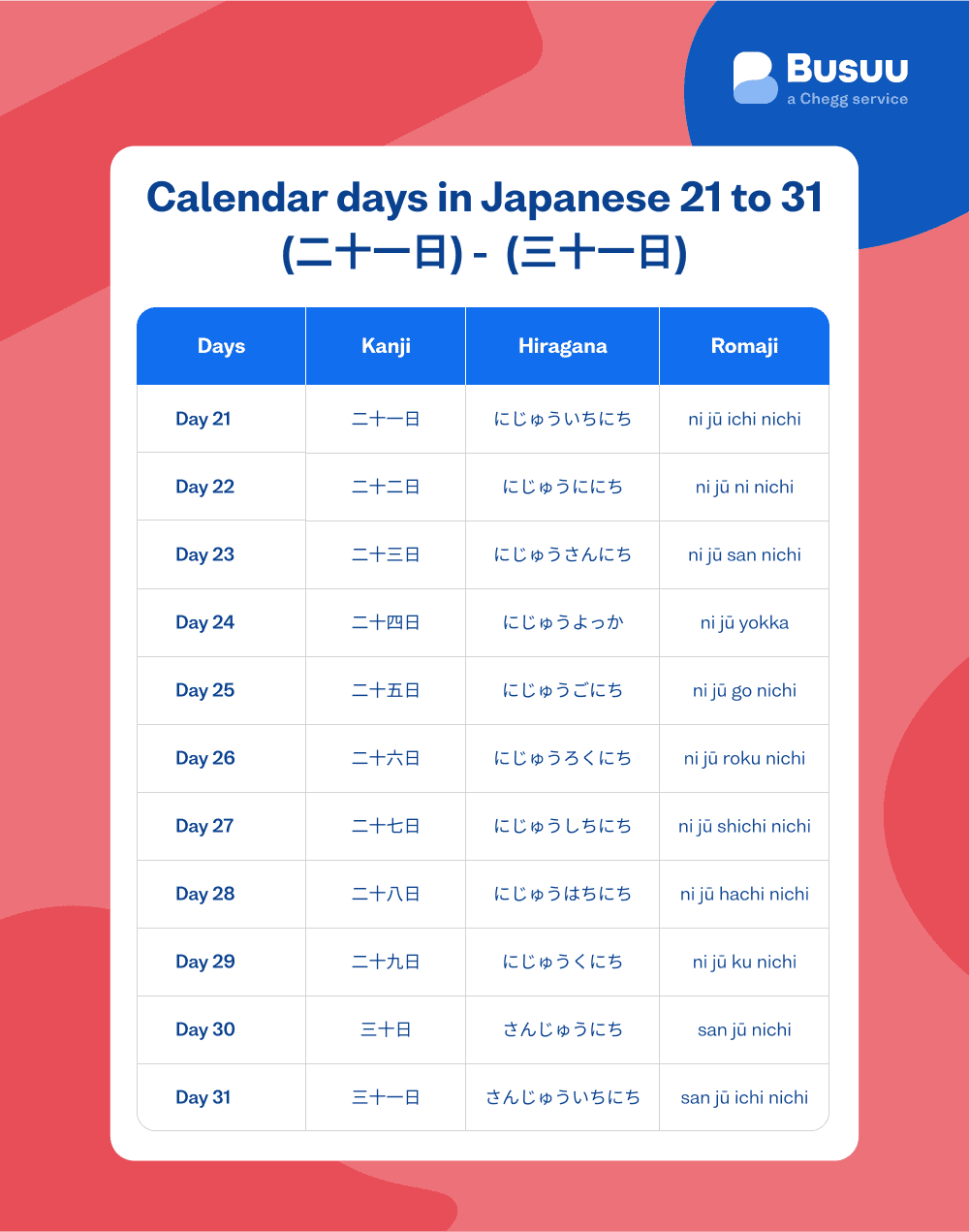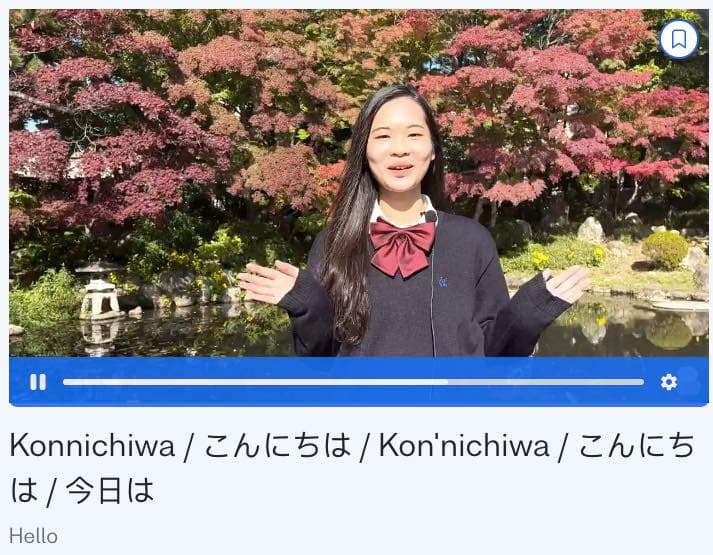I want to learn...
As you start your journey in learning Japanese, you’ll want to make plans for future dates using the days of the month in Japanese. Knowing the Japanese days of the month is essential to do this. Today, we will go over how to say and write the days and break it down for you into segments in a way that’s easy to understand. Like when we discussed learning colors in Japanese, in this article, we want to simplify how to say the days of the month in Japanese so that you can communicate clearly.
There’s no question that it takes practice to get it down to a point where you no longer need a reference chart. However, we want to give you a starting point that will make you feel comfortable taking on learning Japanese days of the month without feeling overwhelmed and instead provide you with confidence.
The first 10 calendar days in Japanese
There’s no time to waste, let’s get to learning! First things first, you will want to begin with the first ten days of the month. Here is why you need to pay close attention. The first ten days sound more similar to native Japanese than Sino-Japanese numbers (Sino-Japanese numbers originate from Chinese), which are used in the majority of the calendar. With the exception of the first day of the month, all the names for the first ten days of the month end in ka (か).
The first day of the month will be the only day in the entire month that ends in tachi (たち).
Since it is the one and only time that you use it, it is easy to remember, and it helps that it’s at the beginning of the month, making it hard to forget. One of the first things you’ll notice as you begin learning about the days of the month on Busuu is that you use the Kanji for the number and then the Kanji for the day. Busuu has created a chart of Japanese numbers in case you need to reference them for this article or during your lessons.
To better understand the days of the month in Japanese, we’ve included charts throughout this article that display them in written form in kanji, hiragana, and romaji. If you’re not familiar with Romaji yet, it is Japanese but written in the Roman alphabet and can be very helpful during your Japanese language learning journey.

Calendar Days in Japanese 1 (一日) - 10 (十日)
| Days | Kanji | Hiragana | Romaji |
|---|---|---|---|
| Day 1 | 一日 | ついたち | tsuitachi |
| Day 2 | 二日 | ふつか | futsuka |
| Day 3 | 三日 | みっか | mikka |
| Day 4 | 四日 | よっか | yokka |
| Day 5 | 五日 | いつか | itsuka |
| Day 6 | 六日 | むいか | muika |
| Day 7 | 七日 | なのか | nanoka |
| Day 8 | 八日 | ようか | youka |
| Day 9 | 九日 | ここのか | kokonoka |
| Day 10 | 十日 | とおか | tooka |
Using Sino-Japanese to say the days of the month
In this following breakdown, we will look at days 11 through 20. Breaking up the month into three parts will help you focus on how to say the days of the month in Japanese in a digestible manner and won’t make you feel like it is a herculean task.
As we mentioned above, it’s only in the first ten days of the Japanese calendar month that consecutively end in ka (か). This set of days all end in nichi (にち), with a couple of exceptions, the 14th and the 20th end in ka (か). You’ll also notice that the 11th through the 13th and the 15th through the 19th are no longer in Native Japanese and instead use Sino-Japanese.
Although Japan adopted the Gregorian calendar in 1873, the traditional calendar used methods first developed in China, which has continued in the transition from the traditional Japanese calendar to the modern one.

Calendar days in Japanese 11 (十一日) - 20 (二十日)
| Days | Kanji | Hiragana | Romaji |
|---|---|---|---|
| Day 11 | 十一日 | じゅういちにち | ju ichi nichi |
| Day 12 | 十二日 | じゅうににち | ju ni nichi |
| Day 13 | 十三日 | じゅうさんにち | ju san nichi |
| Day 14 | 十四日 | じゅうよっか | ju yokka |
| Day 15 | 十五日 | じゅうごにち | ju go nichi |
| Day 16 | 十六日 | じゅうろくにち | ju roku nichi |
| Day 17 | 十七日 | じゅうしちにち | ju shichi nichi |
| Day 18 | 十八日 | じゅうはちにち | ju hachi nichi |
| Day 19 | 十九日 | じゅうくにち | ju ku nichi |
| Day 20 | 二十日 | はつか | hatsuka |
Note to reader: The 20th is a distinctive date not only because it ends in ka (か), but because it also uses a special reading for 二十, hatsu (はつ).
The final segment of the days of the month in Japanese
We’ve made it to the latter part of the calendar; how are you feeling? Hopefully, you’re still excited and eager to keep learning. We understand that learning a new language can be daunting, especially when it doesn’t follow your native alphabet, but it can also be thrilling! It may not stick with you right off the bat, but the more you review the charts, the easier it will get.
While not all months have 31 days, some months do, and it is essential to know how to say the 31st day along with every other day. In this segment, we learn how to say days 21 through 31. As with days 11 through 20, we continue to see nichi (にち) at the end of each day, with one exception. In this case, the 24th is the standout date ending in ka (か). Remember, outside of the first ten calendar days, the only other days not ending in nichi (にち) are the 14th, the 20th, and the 24th.

Calendar days in Japanese 21 (二十一日) - 31 (三十一日)
| Days | Kanji | Hiragana | Romaji |
|---|---|---|---|
| Day 21 | 二十一日 | にじゅういちにち | ni jū ichi nichi |
| Day 22 | 二十二日 | にじゅうににち | ni jū ni nichi |
| Day 23 | 二十三日 | にじゅうさんにち | ni jū san nichi |
| Day 24 | 二十四日 | にじゅうよっか | ni jū yokka |
| Day 25 | 二十五日 | にじゅうごにち | ni jū go nichi |
| Day 26 | 二十六日 | にじゅうろくにち | ni jū roku nichi |
| Day 27 | 二十七日 | にじゅうしちにち | ni jū shichi nichi |
| Day 28 | 二十八日 | にじゅうはちにち | ni jū hachi nichi |
| Day 29 | 二十九日 | にじゅうくにち | ni jū ku nichi |
| Day 30 | 三十日 | さんじゅうにち | san jū nichi |
| Day 31 | 三十一日 | さんじゅういちにち | san jū ichi nichi |
How to use the days of the month in Japanese
Now that you have the charts for the days of the Japanese calendar, you may wonder how to use them in conversation. We have created a few examples as a tool for you to reference here below to help see them used in context.
Example 1:
Would you like to have a meal with me on the 20th? 二十日 に一緒に食事をしませんか。Hatsuka ni isshoni shokuji o shimasen ka.
Here we show you how to ask someone if they want to do a specific task or pastime with you.
Example 2:
I plan to leave on my business trip on the 6th of next month.
来月の六日に出張に行く予定です。Raigetsu no muika ni shucchō ni iku yotei desu.
This is an example of how to state your plans for a specific day of the month.
Example 3:
I went to Tokyo with my mother on the 23rd.
二十三日に母/はは/と東京に行った。Ni ju san-nichi ni haha to Tōkyō ni itta.
Note to the reader: It is very common today for people fluent in Japanese to use the international number in writing. For instance, in our last example, instead of writing 二十三日 for the 23rd, you might see 23日.
From ka to nichi, you did it!
How does it feel to be more familiar with how to say the days of the month in Japanese? We know at the beginning of this article, it may have felt like a daunting task, but we hope that as you reviewed each chart and read through each section, you found that you have a better understanding of the calendar and how to start using it in conversation.
Japanese lessons on Busuu will, without a doubt, help hone it in, and in no time, you’ll feel comfortable using the days of the month in casual conversation. Remember that this article is always here for you to come back to in case you need to reference it or want to save the charts we’ve provided. Always remember it takes time and patience, but you’ve got this!
Newlanguages


